Mindfulness re-enchants life – it makes everything better and more enjoyable.
Like a sage with a playful twinkle in his eye, mindfulness is ancient. And yet, it still retains a childlike simplicity that makes it accessible to nearly everyone.
On a scientific and spiritual level, mindfulness has been proven to calm the mind, ground the body, and increase overall well-being and good health.
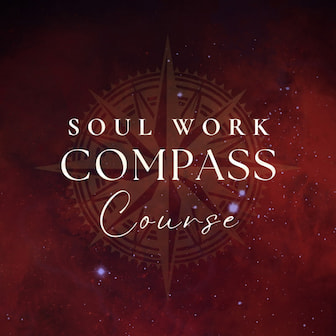
Soul Work Compass Course:
Feeling lost, stuck, and trapped in repetitive cycles of pain? Discover your Soul's Compass to reclaim your purpose and find your path to freedom.
⭐️⭐️⭐️⭐️⭐️ "I have been a long-time subscriber to their website, and it’s one of my favorites by far ... It is rare to find this type of teacher." – Shar B.
Yet, when it comes to practicing mindfulness, many of us quickly get bored, distracted, or frustrated.
Aka. mindfulness sounds nice in theory.
But in practice, mindfulness exercises rapidly get shoved somewhere on our mental “to do” list – that, or it’s just ‘too difficult’!
How is it possible for 21st-century people who DON’T live in monasteries to incorporate mindfulness practices into their lives?
Is mindfulness even compatible with our busy and hectic lifestyles?
And how do we approach mindfulness if we’ve got the mind of a hyperactive monkey on steroids?
Table of contents
What is Mindfulness?

In a simple down-to-earth nutshell, mindfulness is about paying attention to what’s happening right now.
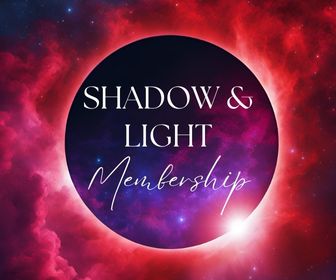
Shadow & Light Membership:
⭐️⭐️⭐️⭐️⭐ "Receiving these messages is a beacon of light and hope for me in currently very challenging times. The words of wisdom speak right to my soul, guiding and encouraging me further on my path. I highly recommend Shadow & Light to everyone who seeks to develop and cultivate a relationship with the Inner Self." – Karin
As a species of human doings (not human beings), we’re almost always lost in the mindset of do, achieve, consume, and produce.
Our minds float to the past or the future. We’re frequently lost in maelstroms of thoughts, worries, plans, memories, or stories of what he-said-she-said.
Mindfulness is about helping us to chill out and focus on the present moment.
Mindfulness and Spiritual Awakening

As mainly a secular practice in the West, the mindfulness we usually hear about these days doesn’t involve a whisper of religion or spirituality.
Instead, mindfulness is promoted as a powerful way of increasing focus, work performance, lowering stress, and improving relationships.
Now, this is all fine and good.
Mindfulness doesn’t have to be spiritual.
But the good news is that it can be.
In fact, mindfulness is a practice that originally stemmed from Eastern spiritual meditation practices – some date this practice back to beginning around 2,500 years ago (1).
The reality is that mindfulness was initially intended for spiritual development and transformation. Words and practices originally connected with it were Sati, Vipassana, and Zazen (1).
Would you like to save this?
Your information will never be shared.
As a spiritual seeker (i.e., someone going through an existential crisis and spiritual awakening), mindfulness can help you:
- find your inner Center,
- disidentify with thoughts,
- reconnect with a sense of Oneness,
- experience moments of self-realization
There are a hoard of spiritual practices and techniques out there, but few are as old and therefore reliable, as mindfulness.
If you’re to take on any path or spiritual discipline, mindfulness is therefore definitely one you’d do well to commit to.
Mindfulness + Meditation (aka. the Match Made in Heaven!)
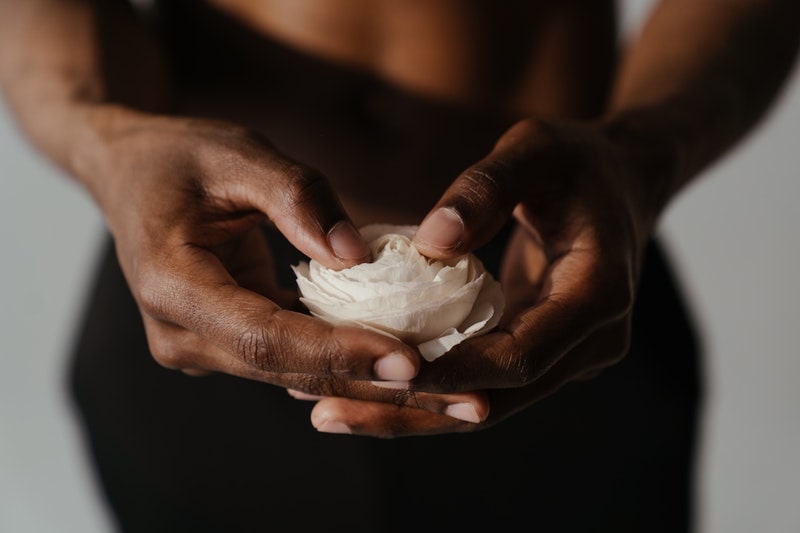
One of the simplest ways to commit to a daily mindfulness practice is by practicing mindfulness meditation.
Mindfulness done alone can feel pretty open-ended and vague – let’s be honest!
Mindfulness meditation, however, takes mindfulness and turns it into a meditative experience.
It’s a match made in heaven!
Perhaps one of the most powerful parts of mindfulness meditation is that it helps you to hone the qualities of:
- non-attachment,
- present moment awareness,
- clarity,
- the experience of our True Nature (which is deeper than thoughts and emotions)
Why You Are Not Your Thoughts

You are the sky. Everything else is just the weather.
– Pema Chodron
Of all the experiences I’ve ever had on my spiritual journey, understanding that I am not my thoughts was one of the most profound.
And it was thanks to mindfulness (specifically, mindfulness meditation) that I discovered this.
Why was this realization so paradigm shifting?
Understanding that we are not our thoughts is a central key to accessing inner peace and Soul alignment.
When we’re attached to and identify with our thoughts and emotions, we suffer horribly. Some people are so entrenched in their thoughts/emotions that they’re driven to suicide.
Mindfulness exercises and practices help us to go from “I AM angry,” to “I HAVE anger” or “I AM anxious” to “I HAVE anxiety.”
There’s a clear distinction here. On one hand we’re totally identified with our anger/anxiety. On the other, we realize it’s a part of us, but it doesn’t define us.
For over 12 years, we've poured our hearts into creating free content on this website. Unlike many platforms, we believe this guidance should be accessible to everyone. If this post empowered you in any way, please consider making a donation to keep us going. Any amount (one-time or ongoing) makes a huge difference.
It’s All Spontaneous, Baby!
Mindfulness also helps us to realize the spontaneity of thoughts, feelings, and sensations – meaning we stop taking ownership of them!
Have you ever sat down to genuinely question where your thoughts and subsequent feelings come from, for instance?
If you have, you would’ve discovered that thoughts appear out of nothing in the mind, and just as quickly disappear into nothing.
Did you make that thought arise? Did you think, “I will now think about this, then this, then this …”?
Even if you do decide to think a certain way (like positive thoughts), did you control where that desire to think positively came from? Did you control the circumstances that led to this desire? No. Of course not!
To truly understand that our thoughts and feelings are impersonal (nothing to do with us) is a divinely shocking revelation. For me to discover this was liberating.
So … if thoughts and feelings are completely impersonal in nature (as in, we don’t own them), then how can they be “ours”?
Mindfulness reveals to us that the suffering we experience in life occurs when we claim these thoughts and feelings to be our own.
In other words, we feel anxiety, depression, guilt, and anger when we identify with thoughts as being “ours” – and not fluctuations of the mind.
“Where Does This Thought Come From?”

Is this hard to understand? I know it may be difficult to fully grapple with the fact that our thoughts and emotions don’t define us. We don’t even control where or when they come!
So I’m not asking you to believe anything I say.
You can experience it for yourself.
All you have to do is sit down for a few minutes, allow yourself to tune into the never-ending stream of thoughts in your mind, and explore where they come from.
Ask yourself, “where does this thought come from?”
It’s so hard for us to extract ourselves from the tangle of our thoughts and feelings because we have been taught since birth to identify with them.
So what I write may sound confusing — but that’s because we’re conditioned to believe otherwise! Like a fish that doesn’t know it’s swimming in the ocean, our lifelong conditioning causes us to adopt a myopic perception of life and ourselves.
To recognize that the fleeting nature of thoughts and feelings really have nothing to do with “us” opens a rare door. This door helps us to discover that which never changes within us: the field of calmness or silence that is the Soul.
This field of calmness, or silence, exists behind our thoughts, and it pre-dated our current sense of self.
We were born with this field of calmness before any concepts of “me” and “I” was ingrained into us, and we carry this calmness with us everywhere and in every moment.
By the way, if you want another way of thinking about mindfulness, I made this video with Luna:
8 Simple Mindfulness Exercises
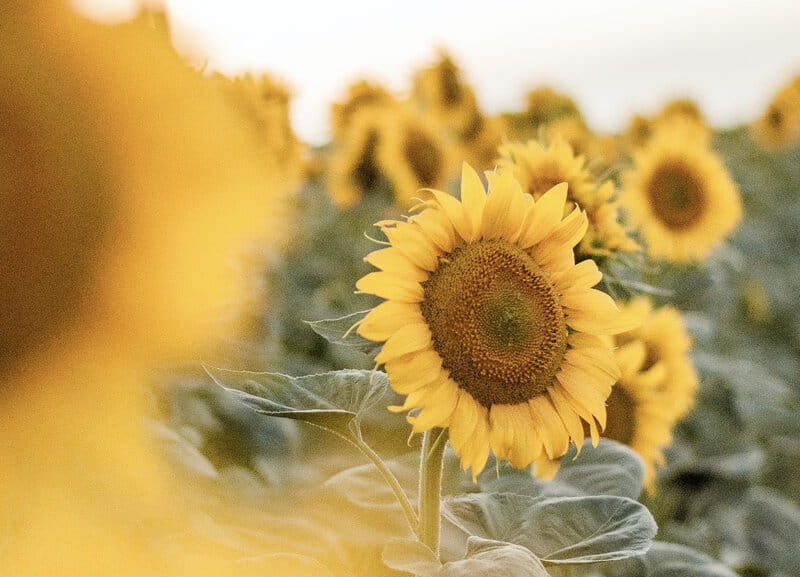
Mindfulness is a way of befriending ourselves and our experience.
– Jon Kabat-Zinn
Mindfulness practices will only be effective if they’re taken seriously.
To put it bluntly, you must practice like your ass is on fire!
There has to be passion, willfulness, and dedication directed towards mindfulness, otherwise, you’ll quickly lose interest.
Lukewarm half-assed practice only leads to disappointment.
That being said, it’s normal to feel lazy. It’s only human to want to give up. That’s why keeping a journal alongside your practice can help to motivate you. Learn more about how to journal.
Joining a community full of mindfulness exercises and enthusiasts can help too (such as the InsightTimer, Calm, or Headspace app).
Remember, mindfulness isn’t about achieving some special state or perfect utopia. (It doesn’t exist!) Instead, mindfulness is simply about becoming aware of whatever is happening right now, whether that be a physical sensation, a sound, a thought, a smell, an emotion, etc.
Mindfulness goes hand-in-hand with allowing things to be exactly what they are in the moment, whether that be a feeling of loneliness …
… a sensation of dread in your stomach …
… a leaky pipe dripping …
… a dog barking, the need to shout, the need to cry, the need to laugh, the craving for food, and so on!
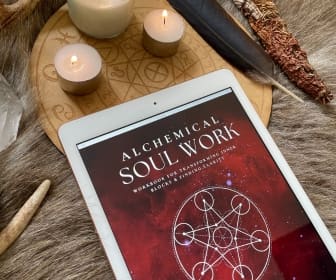
Feeling stuck?
Take the first step on your path of transformation. The Alchemical Soul Work Workbook is a practical guide to help you heal, grow, and reconnect with your inner purpose.
I love mindfulness. Here are some key mindfulness exercises to explore – suitable for total beginners and long-term aficionados alike:
1. Do everything slowly
Consciously slow down. Walk slowly, drink slowly, sit slowly, breathe slowly, talk slowly, move your body slowly — practice slowing down your natural tendency to rush everything.
Try doing this mindfulness exercise for at least 1 hour.
The immediate reaction to this practice is usually, “I can’t do that! I have deadlines to meet, etc., etc.”
But when you learn to go slowly, you’ll recognize the sheer volume of how many things you cram into your days which you don’t actually need to do!
As a result of this realization, you’ll learn to focus solely on what you need to do and become more efficient.
You can also choose one action to do slowly like walking, eating, or breathing.
Allow yourself to fully connect with whatever you’re doing slowly. Pay attention to each micromovement.
It’s normal to find it difficult (and frustrating) at first to adapt to such a slow pace – but stick with it!
Soon, with practice, movement itself will become a trigger to become more mindful and present.
2. Witness your breath
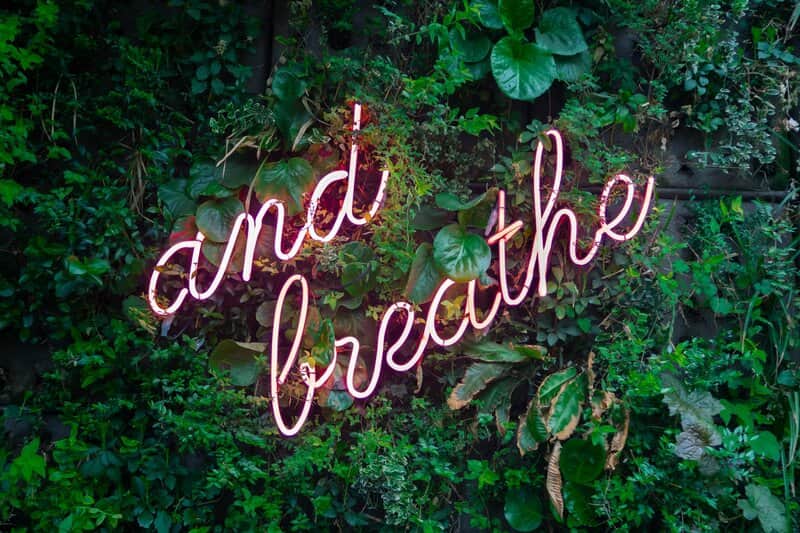
How many times have you tried to breathe slowly, only to find yourself getting lightheaded or panicky?
I know that when I’m feeling stressed, the worst thing for me to possibly do is to try and control my breathing. Instead of feeling relaxed, I feel more on-edge.
The better alternative to controlling your breath is to witness it rising and falling within you. How do you do this?
To witness your breath, you must consciously stop in the present moment and simply observe what your breathing is doing.
For example, if you’re breathing shallowly from your upper chest, simply witness and allow that breathing to happen.
Soon, the very act of witnessing and allowing your breath will calm you down, giving you the space to deepen your breathing if you wish.
No matter if your breathing is rapid or constricted or neutral or deep, just allow it to be that way. This type of acceptance is a natural form of mindfulness.
3. Feel your inner body
This mindfulness exercise technique was inspired by Eckhart Tolle in his book “A New Earth” in which he mentions the subtle energy inside us which he calls the “inner body.”
To feel your inner body:
Simply draw attention to one area of your body, such as your hand, foot, chest or head. Allow yourself to feel the life force energy in that one particular area. For example, let your attention settle fully on your hand. What does the inner body feel like there? Is it heavy, tingly, warm, tight, buzzing?
Eventually, you can draw awareness to other areas of your body until you can feel your entire inner body.
With practice, you’ll be able to become aware of your inner body even while talking with others.
This mindfulness practice also allows you to loosen your identification with your body, making it a good tool for spiritual awakening.
4. Let eating become a symphony of flavors and textures!

Make a habit of using food as a mindfulness anchor.
Generally, whenever we eat we’re doing something ELSE as well.
For example, most of us eat in front of the TV, eat while using our phones, eat while talking, eat while reading the newspaper, eat while thinking about something … etc.
We’re rarely fully present with our food.
Most of us have forgotten or unlearned how to simply BE with our food. Food is made to enjoy and nourish the body, yet most of us mindlessly shovel it down like the world is going to end.
Eating consciously is one of the most enjoyable mindfulness exercises out there – it allows you to enjoy the sensuality and indulgence of something we do every day!
So let the flavors, textures, scents, and temperature of your food enrapture your taste buds.
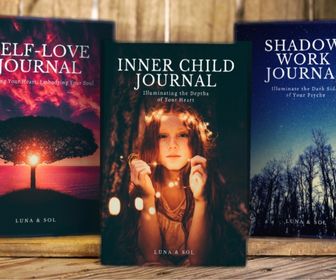
Inner Work Journal Bundle:
Ready to take your spiritual practice to new depths? Our highly-rated set of guided inner work journals leads you step-by-step through processing trauma, transmuting pain into power, and finding transformation through deep healing and self-illumination.
When distractions arise (as they inevitably will), just draw your focus back to having a full-being experience of your food.
5. Dedicate one day a week to becoming mindful of each of your five senses
For example, on Monday you could pay attention to sound, on Tuesday the sense of touch, on Wednesday the sense of smell, etc.
You could even try incorporating other senses such as intuition or instinct, by paying attention to the physical sensations you get in certain places, situations, and around other people.
On Monday, for instance, you could train yourself to become alert to physical sensations such as when you touch something, brush against someone, move your body, type on your computer, etc.
Eventually, you’ll begin to become anchored firmly into the present moment through all of your senses.
6. Spend more time in nature each day

Spend more time outdoors. Even if all you can see is a skyline of rooftops or buildings, you always have the sky to gaze at.
Living indoors all day tends to restrict the mind immensely. By going outside, you open your mind to experiencing more expansion and relaxation.
Sitting outside is one of the most simple mindfulness exercises out there that involves minimal effort. All you have to do is commit to sitting and watching whatever comes into your field of vision for at least half an hour.
7. Do a walking meditation
One of my favorite mindfulness exercises is doing walking meditations. The convenient thing about this practice is that you can incorporate it into your daily exercise regime.
Walking meditation is extremely simple and profoundly grounding. All it involves is becoming aware of the sensation of the ground beneath your feet.
I’ve been doing walking meditations for a few years now. My favorite part is feeling the rhythm of my feet against the earth in all of its varied textures (wet, soft, gravelly, rocky, etc.).
To practice walking meditation, allow your focus to rest in the movements of your feet. Literally, “put yourself in the shoes” of your feet and purely experience what they are experiencing.
Remember, no sensation has to be “better” or “worse” than another. The purpose of mindfulness is to not only live in the moment but to also become aware of the thoughts that arise in your mind and let them go.
Walking meditation is a wonderfully active way of letting go of thoughts and being right here, right now.
8. Gratitude prayer
Saying a prayer of thanks for what you have every day is one of the most transformative mindfulness exercises out there.

Soul Work Compass Course:
Is a vague sense of emptiness lurking beneath the surface? It’s time to reclaim your life. The Soul Work Compass Course helps you break free from self-doubt and repetitive pain. Don’t just survive – thrive by creating a personalized map for your future. Start your journey to profound self-discovery and authentic life direction now.
Gratitude can only ever exist in the present moment, thus, it is the perfect mindfulness tool.
When we’re lost in our thoughts, it’s so easy for us to take what we have for granted and constantly seek more.
Gratitude grounds us in the here and now. Whether you believe in God, Life, Spirit, science — it doesn’t matter — verbalize your thanks either silently or out loud, and you’ll become more present-minded.
Here’s a sample gratitude prayer,
Thank you God/Life/Spirit for all that I have in this eternal present moment. I am so grateful and blessed.
You can also try gratitude journaling where you list the ten things you’re thankful for each day.
Read: 7 Scientifically Proven Benefits of Being Grateful »
Mindfulness FAQ

There are five main ways to practice mindfulness that correspond with our five senses:
– Mindfulness of sounds
– Mindfulness of smells
– Mindfulness of flavors
– Mindfulness of feelings/textures
– Mindfulness of what we see
To begin practicing mindfulness, start small:
1. Focus on one mindfulness exercise
2. Commit time to it each day (e.g., set a reminder or notification on your phone)
3. Journal about the discoveries or epiphanies you have
4. Continue the mindfulness exercise for one week
5. Reflect on what you’ve learned (and continue or find a more suited practice!)
If you struggle with anxiety, being mindful might feel daunting. Trauma-informed mindfulness author David A. Treleaven advises staying grounded and oriented to your surroundings. Focus on that which makes you feel safe and relaxed. For example, that might mean being mindful of a pleasant smell in the air or the trees outside. If being mindful of your breath helps, focus on that. Try to avoid anything that triggers your anxiety.
Conclusion
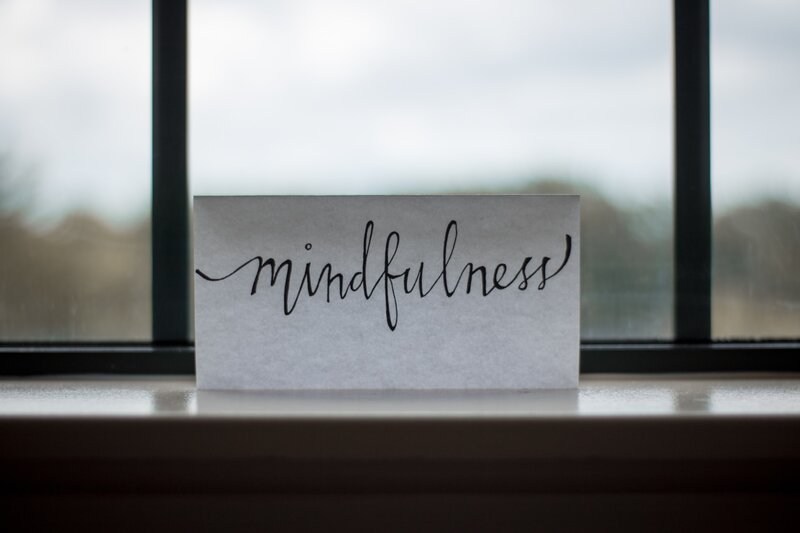
Mindfulness is the practice of returning back to reality again.
Remember that thoughts and feelings never objectively mean anything about you: they simply arise and fall, come and go.
In the words of mindfulness teachers Danny Penman and Mark Williams:
Mindfulness is about observation without criticism; being compassionate with yourself. When unhappiness or stress hovers overhead, rather than taking it all personally, you learn to treat them as if they were black clouds in the sky, and to observe them with friendly curiosity as they drift past. In essence, mindfulness allows you to catch negative thought patterns before they tip you into a downward spiral.
I hope these eight mindfulness practices have inspired you to find the magic again in everyday life.
Mindfulness is a powerful tool that can help us move through inner obstacles, dissolve blockages, and find a sense of inner peace and freedom.
I’d love to know your favorite mindfulness exercises and practices. So share them with me in the comments!
Whenever you feel the call, there are 2 ways I can help you:
1. The Soul Work Compass Course: Ready for deep transformation without the fluff? The Soul Work Compass provides a step-by-step path to finding your inner truth and life direction. Heal core wounds, clarify your values, and walk away with a concrete guide for living. Get started now!
2. The Inner Work Journal Bundle: Stop surface-level healing. Dive into the depths with 150+ journaling prompts designed to help you face your demons, heal childhood wounds, and embrace your shadow. Three sacred journals, lifetime access, print as many times as you need. Real transformation starts here.

 $3
$3
My main issue with mindfulness is that I constantly feel required to have thoughts. I feel like if I could choose to not have them I would but because I have 0 control over them I can’t make them stop (which is what I want). Therefore I honestly have no clue how to make this process work. Maybe I’m missing something.
Hey Carina,
What you share is actually quite common and stems from a misconception of what mindfulness is. It’s not necessarily being thought-free, although that can happen, but being present with those thoughts. If you picture the thoughts as clouds floating in the sky that is your mind, then you’re essentially taking a step back and watching the clouds rather than being lost in the sight of them, which is how most of us spend our time by default with the content of our minds. I hope that clarifies things a bit. :)
Mindfulness is not about not having thoughts, otherwise it would have been called Thoughtless practice. The same is true for meditation as well. Meditation or mindful meditation is not about not having thoughts but about becoming aware of the thoughts that arise.
To be mindful means to become aware of your thoughts. Like Mateo wrote, it gives you the choice to either take ownership and identify with your thoughts, or to let them go like the clouds in the sky.
To become aware of your thoughts means exactly that, to become aware of what you are thinking. Are you judgmental, frustrated, angry, happy, euphoric, depressed, feeling anxious and so on? When you become aware of being judgmental about yourself or someone else, you instantly have the choice to acknowledge these thoughts, understand what triggered them, and let them go. This way they do not ‘take you over.’ You choose to be the master of your thoughts instead of letting your thoughts master you.
You will come to realize that this is much more gratifying than not having thoughts at all. It will enrich your life in so many more ways than you can imagine.
Being in an extremely difficult situation of trying to recover my own health, while being responsible 24/7 for recovery/care of a loved one, while having had home and business stolen in an illegal foreclosure and with no permanency to any aspect of our lives, I can attest to successfully being in a state of constant meditative mindfulness that repeatedly makes me grateful to be alive and caring. Whenever I sense the tension rising to overload I ask inner questions: does this really matter… Am I giving power to making nonsense matter?…in this single moment is everything ok? Nasal breathing with consciousness and intent to stay calm. Think like a monk, be silent, observe and truly see and hear better. It makes one more grounded in what has importance, and happier. Blessings to you both for fantastic articles that teach so much to do many seeking to grow into kinder souls.
Thank you Su, it sounds like you’ve put these skills through a true fire test with all those unfortunate situations. At the end of the day, that’s all any of us really have any control over, how we respond to the world both in joy and in suffering. Mindfulness is a powerful skill for this.
Hello.
Great article.
Since a couple of years this is what I have to practice and learn.
A Shaman once told me that my mind and Soul are ever travelling, by day and by night. And that’s how it really is with me.
So I am trying to be more present in the…well, present, grin.
Those exercises are a nice addition that I can implement. Thank you.
To me, being in nature is really beneficial. Regardless of if you walk or rest, as you connect deeper with all automatically.
I am having my most present moments out there.
All the best in gratitude,
Shaj
Thank you Shaj, I completely agree with the nature element; it has a powerful way of evoking presence through its expansiveness and aliveness. The simplest mindfulness exercise of all, sitting in nature for 60 minutes doing absolutely nothing and not even trying to be mindful. It’s often enough for most to temporarily get them out of a rutt. :)
This really gave me insight! Thank you for all this amazing information! I don’t think it was an accident that I stumbled upon your site.
Me neither Kaiti, thank you for being here ♡
I could use some practice. Mindfulness has been a subject which comes up often and I’ve searched high and low since I read it in another article of yours about a month ago.
I was in a treatment facility to recover from addiction and there was first introduced to the concept of Mindfulness, living in the here, now! I am reading and searching my heart. Next I’m going to paste a comment to a conversation I had with my 74 year old mother earlier in the evening. It’s the best way to say why I’m up all night searching, and the synchronicities found in Lonerwolf.
It’s hard to get a firm grasp on reality, especially while speaking with another on the subject. Not with everyone. There are times when I’ve really enjoyed a conversation with another, discussing truth and admitting lies, deceptions, excuses, blame, manipulations and the list gets uglier. So why does it seem so much harder to speak freely, opening and honestly with people we know (or maybe just think we know), those closest to us? A conversation quickly turns to an argument. Voices are raised. Attitudes are brought out in the open. We begin to not like what we’re seeing and experiencing in others… in ourselves. Hell, I can go on until daylight. So it seems best that we follow the example of our youth. They stay out of the mix. For me their lifestyle seems false, shallow, more of an illusion. But what do I know? Maybe I’m the one lost in an illusion, in self delusion? I don’t know anymore… and it hurts deeply.
Thank you Aletheia, Mateo, The Pack
What a wonderful mindfulness primer. I love you both, each article i have read so far resonates with my own experience. Every blessing to you both ~ peace – bob p.
Thank you for this. I recently finished reading Eckhardt Tolle’s The Power of Now and I really enjoyed it. However, I’ve struggled finding some simple ways to experience Now. These tips will be very helpful.
The things we think/feel about ourselves are not the truth of who we are.
They are not the sum of who we are.
Keyword: transient.
Goal: Abstain from over-identifying with my thoughts/feelings. I am not defined by my thoughts/feelings.
My feelings/thoughts are fleeting and transient.
Got it :).
PS over-identification (with my feelings & my thoughts) is often an issue for me and it’s painful, and ever since I’ve started paying attention to this (and healing it) I’ve managed to function better as a person.
Sometimes I “forget”, because my level of consciousness is reduced to that of my pain (in the moment).
My pain has me seeing and feeling things in a limited/narrow manner.
It’s such an ingrained aspect of my personality, it took quite a bit of practice to stop this, but I have noticed how I’ve become more proficient at not allowing myself to “fuel” or “energize” any unpleasant thoughts/feelings.
Connecting with the pain in my body, feeling into it and releasing it (through the power of intention) is key to healing.
Thank you so much for this article. I have been struggling to meditate for over 2 years now, and this hits the exact spot I have been struggling with. Blessings to you!
When I am stressed, I tend to hyperventilate and feel short of breath. I than try to control my breathing, but I am glad to have read your tip about doing the opposite, just be aware of my breathing.
From a physiotherapist I learned to feel your body and move slowly whenever I start to hyperventilate. It really helps, but I find it difficult to practise it at work…
Tips I will try to incorporate in my life will be eating without doing anything else and spending time outdoors. In the weekends I do spend time outdoors, but on workdays I only cycle 15 minutes to and from work.
I don’t do it every day, but speaking out my gratitude always feels nice. I use it sometimes to help me fall asleep. Just sum up everything you are thankfull for, like the house you life in, the friends you have, the cuddles you get form your pets.
I do however find the idea of your thoughts / feelings not being yours difficult to understand. They are made by my mind due to experiences, upbringing, character. And when do you dismiss thoughts and when do you need to listen? I struggle with that.
I agree. I also find this idea difficult to grasp. Why how can thoughts not be mine when sometimes I consciously choose to banish a negative thought and substitute it by a positive one? Luna, can you please explain? Thank you. Thank you for all your great articles. Xxx